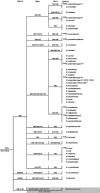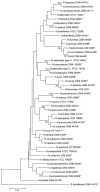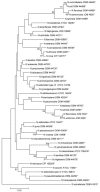Use of PCR-restriction enzyme pattern analysis and sequencing database for hsp65 gene-based identification of Nocardia species
- PMID: 16455910
- PMCID: PMC1392680
- DOI: 10.1128/JCM.44.2.536-546.2006
Use of PCR-restriction enzyme pattern analysis and sequencing database for hsp65 gene-based identification of Nocardia species
Abstract
Nocardia identification required laborious and time-consuming phenotypic and chemotaxonomic methods until molecular methods were developed in the mid-1990s. Here we reassessed the capacity of PCR-restriction enzyme pattern analysis (PRA) of the hsp65 gene to differentiate Nocardia species, including 36 new species. Our results confirm that hsp65 PRA must no longer be used for Nocardia species identification, as many species have the same restriction pattern. We then compared sequencing-based strategies using an hsp65 database and a 16S rRNA database and found that the hsp65 region contained sufficient polymorphisms for comprehensive Nocardia species identification.
Figures



Similar articles
-
Multiple copies of the 16S rRNA gene in Nocardia nova isolates and implications for sequence-based identification procedures.J Clin Microbiol. 2005 Jun;43(6):2881-5. doi: 10.1128/JCM.43.6.2881-2885.2005. J Clin Microbiol. 2005. PMID: 15956412 Free PMC article.
-
Ocular nocardiosis: HSP65 gene sequencing for species identification of Nocardia spp.Am J Ophthalmol. 2007 Oct;144(4):570-3. doi: 10.1016/j.ajo.2007.06.031. Epub 2007 Aug 15. Am J Ophthalmol. 2007. PMID: 17698022
-
Nocardia kruczakiae sp. nov., a pathogen in immunocompromised patients and a member of the "N. nova complex".J Clin Microbiol. 2004 Nov;42(11):5139-45. doi: 10.1128/JCM.42.11.5139-5145.2004. J Clin Microbiol. 2004. PMID: 15528707 Free PMC article.
-
Comparative evaluation of Polymerase Chain Reaction-Restriction Enzyme Analysis (PRA) and sequencing of heat shock protein 65 (hsp65) gene for identification of aquatic mycobacteria.J Microbiol Methods. 2009 Feb;76(2):128-35. doi: 10.1016/j.mimet.2008.09.021. Epub 2008 Oct 10. J Microbiol Methods. 2009. PMID: 18950664
-
Comparison of restriction enzyme pattern analysis and full gene sequencing of 16S rRNA gene for Nocardia species identification, the first report of Nocardia transvalensis isolated of sputum from Iran, and review of the literature.Antonie Van Leeuwenhoek. 2016 Oct;109(10):1285-98. doi: 10.1007/s10482-016-0746-x. Epub 2016 Sep 9. Antonie Van Leeuwenhoek. 2016. PMID: 27613736 Review.
Cited by
-
A French multicentric study and review of pulmonary Nocardia spp. in cystic fibrosis patients.Med Microbiol Immunol. 2015 Aug;204(4):493-504. doi: 10.1007/s00430-014-0360-3. Epub 2014 Oct 26. Med Microbiol Immunol. 2015. PMID: 25344657
-
Merits and pitfalls of currently used diagnostic tools in mycetoma.PLoS Negl Trop Dis. 2014 Jul 3;8(7):e2918. doi: 10.1371/journal.pntd.0002918. eCollection 2014 Jul. PLoS Negl Trop Dis. 2014. PMID: 24992636 Free PMC article. Review.
-
Discovery of Novel Diagnostic Biomarkers for Common Pathogenic Nocardia Through Pan-Genome and Comparative Genome Analysis, with Preliminary Validation.Pathogens. 2025 Jan 6;14(1):35. doi: 10.3390/pathogens14010035. Pathogens. 2025. PMID: 39860996 Free PMC article.
-
Cavitary pneumonia caused by Nocardia otitidiscaviarum.Braz J Microbiol. 2010 Apr;41(2):329-32. doi: 10.1590/S1517-838220100002000011. Epub 2010 Jun 1. Braz J Microbiol. 2010. PMID: 24031500 Free PMC article.
-
Resistance gene pool to co-trimoxazole in non-susceptible Nocardia strains.Front Microbiol. 2015 Apr 28;6:376. doi: 10.3389/fmicb.2015.00376. eCollection 2015. Front Microbiol. 2015. PMID: 25972856 Free PMC article.
References
-
- Boiron, P., F. Provost, and B. Dupont. 1993. Technical protocols, p. 107-126. In Methodes de laboratoire pour le diagnostic de la nocardiose. Institut Pasteur, Paris, France.
Publication types
MeSH terms
Substances
LinkOut - more resources
Full Text Sources
Molecular Biology Databases
Research Materials

